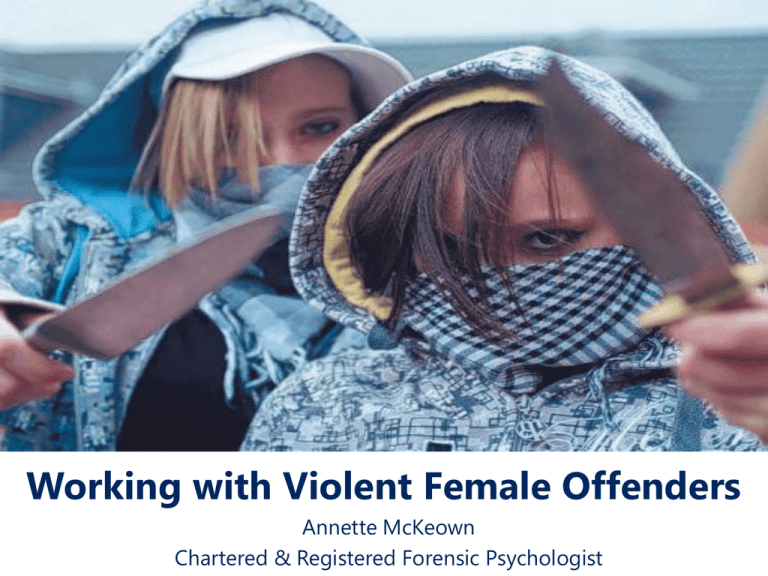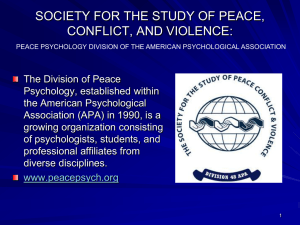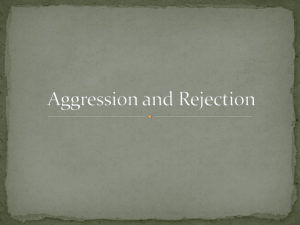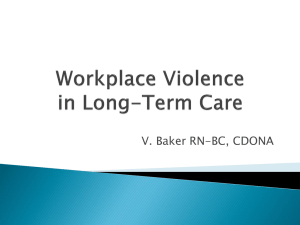Working with Violent Female Offenders
advertisement

Working with Violent Female Offenders Annette McKeown Chartered & Registered Forensic Psychologist Aims & Objectives • Different Forms of Female Aggression & Violence • Understanding Female Aggression & Violence • Female Hidden Violence • Working with Female Violent Offenders Division of Forensic Psychology Conference High Number of Female Violent Offenders in Prison Population Total Female Sentenced Prison Population March 2013: 3060 36 Violence against the person Sexual offences 500 839 18 Robbery 482 70 296 180 186 453 Burglary Theft and handling Fraud and Forgery Drug offences Motoring offences Division of Forensic Psychology Conference Increasingly Violent Women in the Media Division of Forensic Psychology Conference June 2013 Increasingly Violent Women in the Media Division of Forensic Psychology Conference June 2013 Different Forms of Female Aggression Understanding Aggression and Violence in Females (1) Victimisation & Trauma Violence & Aggression Relationship Difficulties Substance Use Mental Health Problems Swan and Snow (2006) Understanding Aggression and Violence in Females (2) • Gender differences from young age. • Boys more likely to be directly and verbally aggressive. • Indirect and relational aggression particularly common in girls (Crick et al., 2008). • Aggressive behaviour in girls noted to include: Excluding another child Intentionally ending a friendship Gossiping (Crick, 1996) Understanding Aggression and Violence in Females (3) • Female violence often in private, domestic arena against themselves or children (Motz, 2010) • More likely to murder an intimate partner and less likely to murder a stranger (Chan & Frei, 2012). • Similar levels of domestic violence (Archer, 2000; Winstok & Straus, 2011). Understanding Aggression and Violence in Females (4) • Suggestions that girls increasingly becoming involved in gangs (Chesney-Lind & Pasko, 2004). • • • Understanding Aggression and Violence in Females (5) 8% of women committed violence alongside a male vs. 1% of male offenders (Bureau of Justice Statistics, 1999) Mothers more likely to murder in infancy whereas fathers more likely to murder when over age of 8. Between 1976 and 1997, mothers and stepmothers committed half of murders of children Division of Forensic Psychology Conference Women’s Hidden Violence in the Home • Denial of female aggression (Motz, 2010) • Idealization of motherhood • Abusive mothering across generations •Projection of own experience of childhood •Violence against own body and children as means of communicating distress(Motz, 2010) Division of Forensic Psychology Conference Women’s Violence Against Children • Munchausen’ s Syndrome equally spread in men and women • 85% Munchausen’s By Proxy cases were mother (McCLure et al., 1996) • Most severe cases usually involve children under age of five. • Primary purpose is to gain some form of internal gratification, such as attention. Female Domestic Violence • • • • Women as likely to perpetrate domestic violence as men (Archer, 2000; 2002; Bookwala, 2002) Some cases more severe forms of violence than men (Cercone et al., 2005) Female prison populations indicate more often perpetrator than victim in most recent relationship No gender-specific treatment programmes Treatment Challenges with Violent Women Splitting Boundaries Stress Transference Counter Transference Victim/Perpetrator Division of Forensic Psychology Conference Ways forward WORK COLLABORATIVE LY WITH TEAM SUPERVISION & CONSIDER DYNAMICS GENDERSENSITIVE INTERVENTION FOR DOMESTIC VIOLENCE & CHILD OFFENCES GREATER AWARENESS OF HIDDEN VIOLENCE CONSIDER RELATIONSHIP DYNAMICS & PARALLELS Division of Forensic Psychology Conference Thank you! Any questions? Annette.mckeown01@hmps.gsi.gov.uk Division of Forensic Psychology Conference









